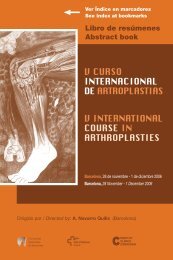Notas / Notes - Active Congress.......
Notas / Notes - Active Congress.......
Notas / Notes - Active Congress.......
You also want an ePaper? Increase the reach of your titles
YUMPU automatically turns print PDFs into web optimized ePapers that Google loves.
VIERNES / FRIDAY<br />
184<br />
13. Laskin RS: Flexion space configuration in total knee<br />
arthroplasty. J Arthroplasty 10:657, 1995<br />
14. Grood ES, Stowers SF, Noyes FR: Limits of movement<br />
in the human knee. J Bone Joint Surg 70-A: 88, 1988<br />
15. Stähelin T, Kessler O, Pfirrmann C, Jacob HAC, Romero<br />
J: Fluoroscopically assisted stress radiography for varusvalgus<br />
assessment in flexion after total knee arthroplasty.<br />
J Arthroplasty 18:513, 2003<br />
16. Mac Williams BA, Wilson DR, Des Jardins JD, Romero<br />
J, Chao EYS: Hamstrings cocontraction reduces internal<br />
rotation, anterior translation, and anterior cruciate ligament<br />
load in weight-bearing flexion. J Orthop Res 17:817, 1999<br />
17. Insall JN, Scuderi GR, Komistek RD, Math K, Dennis DA,<br />
Anderson DT: Correlation between condylar lift-off and<br />
femoral component alignment. Clin Orthop 403:143, 2002<br />
18. Stiehl JB, Dennis DA, Komistek RD, Crane HS: In vivo<br />
determination of condylar lift-off and screw-home in a<br />
mobile-bearing total knee arthroplasty. J Arthroplasty<br />
14:293, 1999<br />
19. Lewis P, Rorabeck CH, Bourne RB, Devane P: Posteromedial<br />
tibial polyethylene failure in total knee replacements.<br />
Clin Orthop 299:11, 1994<br />
20. Romero J., Stähelin T., Binkert C., Pfirrmann C.W., Hodler<br />
J., Kessler O.: The clinical consequences of flexion gap<br />
asymmetry in total knee arthroplasty. J Arthroplasty 22<br />
(2):235-40, Feb 2007<br />
21. Attfield SF, Wilton TJ, Pratt DJ, Sambatakakis A: Softtissue<br />
balance and recovery of proprioception after total<br />
knee replacement. J Bone Joint Surg 78-B:540, 1996<br />
MEASURED RESECTION VERSUS GAP<br />
BALANCING TECHNIQUE<br />
Douglas A. Dennis, M.D<br />
Adjunct Professor, Dept. of Biomedical Engineering, University<br />
of Tennessee; Assistant Clinical Professor, University of<br />
Colorado Health Sciences Center; Clinical Director, Rocky<br />
Mountain Musculoskeletal Research Laboratory<br />
Denver, Colorado (USA)<br />
Controversy persists regarding the most favourable method<br />
to determine accurate femoral component rotation during<br />
total knee arthroplasty (TKA). Some favour a measured resection<br />
technique in which bone landmarks (femoral epicondyles,<br />
posterior femoral condyles, or the anteroposterior<br />
axis) are the primary determinants of femoral component<br />
rotation. Others recommend a gap balancing methodology<br />
in which the femoral component is positioned parallel to the<br />
resected tibia with each collateral ligament equally tensioned.<br />
Recent research has documented that accurate surgeon<br />
identification of bone landmarks is frequently NOT obtained<br />
which can result in flexion gap asymmetry. To test this hypo-<br />
thesis, two hundred twelve patients underwent a total knee<br />
arthroplasty utilizing a computer navigation system (Ci Navigation<br />
System; Depuy, Warsaw, IN). The transepicondylar,<br />
anteroposterior, and the posterior condylar axes were registered.<br />
CAS optimized femoral rotation (gap balancing) was<br />
then compared to use of the anatomic bony landmarks to<br />
evaluate the accuracy of these landmarks in determining rotation<br />
of the femoral component. Comparing the gap balancing<br />
method to the anatomic landmarks, use of the epicondylar<br />
axis for determination of femoral component rotation was<br />
a mean 0.9º externally rotated (range, 12º internal to 16º external),<br />
with the flexion gap balanced (+/- 3º) 43% of the<br />
time. The posterior condylar axis was a mean of 0.4º internally<br />
rotated (range, 15º internal, 13º external), with the flexion gap<br />
balanced 58% of the time. The anteroposterior axis was a<br />
mean of 1.9º externally rotated (range 13º internal, 18º external),<br />
with the flexion gap balanced 39% of the time.<br />
An additional fluoroscopic analysis of TKA performed utilizing<br />
either measured resection vs. gap balancing methods demonstrated<br />
a significantly lower incidence of femoral condylar<br />
lift-off when a gap balancing technique was used, further<br />
confirming the superiority of use of the gap balancing technique<br />
in obtaining a balanced flexion gap.<br />
CONCLUSION<br />
Surgeons have been shown to be inaccurate in locating the<br />
anatomic landmarks recommended for femoral component<br />
rotation. When anatomic landmarks were used to determine<br />
femoral component rotation, an asymmetric, trapezoidal flexion<br />
gap was frequently observed with an increased incidence<br />
of femoral component lift-off. Rotation of the femoral component<br />
using a gap balancing technique results in better gap<br />
symmetry, which should create more favourable knee kinematic<br />
patterns and reduced polyethylene wear.<br />
REFERENCES<br />
1. Fehring TK. Rotational malalignment of the femoral component<br />
in total knee arthroplasty. Clin Orthop Relat Res.<br />
2000;Nov(380):72-9.<br />
2. Poilvache PL, Insall JN, Scuderi GR, Font-Rodriguez DE.<br />
Rotational landmarks and sizing of the distal femur in total<br />
knee arthroplasty. Clin Orthop Relat Res. 1996;Oct(331):35-<br />
46.<br />
3. Whiteside LA, Arima J. The anteroposterior axis for femoral<br />
rotation alignment in valgus total knee arthroplasty. Clin<br />
Orthop Relat Res. 1995;Dec(321):168-72.





